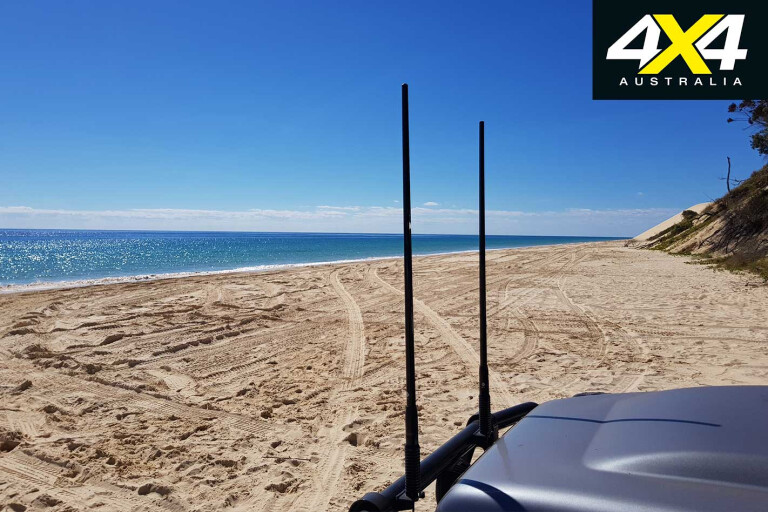
A UHF CB radio is as essential to outback travel as a first-aid kit overflowing with bandages, antibiotics and wet wipes, as both can get you out of a real pickle when you need it most.
Getting stuck up to your axles is bad enough, but not having any form of communication with the real world when you’re outside the realm of phone reception can turn a bad situation into an absolute disaster.
There are many stories of unprepared tourists blowing tyres kilometres from civilisation and sitting roadside for hours – if not days – waiting for someone to drive past. A UHF radio is also an ideal tool for communication with other vehicles in your convoy – and no, not just for the banter.
JUMP HEAD
- Why is a UHF radio essential?
- What to look for
- Risky business
- Fixed or handheld
- Antennas
- Repeaters
- Legally restricted channels
Why is a UHF radio essential?
A UHF CB (Ultra High Frequency Citizen Band) radio affords punters the opportunity to explore vast expanses of remote country without fear or concern that, if mechanical failure or driver error should occur, they’ll be stuck rationing their last bottle of water and half a pack of Pringles.
Put simply, the size of the Australian landscape means that cellular coverage is limited in many areas, so a UHF CB radio provides an open communication platform to allow people to communicate across considerable distances without the need for network coverage.
A UHF CB offers the advantage of being able to communicate to anyone in an area of 5 to 8km, but this can be increased if you're in in a high position and dependent upon the terrain and environment. Another main advantage is easy, accessible comms between vehicles travelling together in a convoy. Anyone who has driven in a convoy understands the benefit of having everyone on the same wavelength, especially between the lead vehicle and the tail-end Charlie.
Doing so can warn trailing vehicles of upcoming obstacles, roadside animals, difficult tracks and oncoming vehicles, and it can also be used to back someone in or navigate someone over a nasty obstacle.
They're essentially an easy-to-use tool for vehicle-to-vehicle communication, particularly where mobile phone coverage is limited or unreliable due to the location, ensuring peace of mind for all users.
What to look for

When browsing the radio pages of an aftermarket catalogue, there are a few key things to look out for before punching in your credit card digits.
Build quality, product support (aftersales/warranty), technical support and battery life are non-negotiables, as is the importance of ‘output power’ – as a 5W unit will transmit further than a 1W unit. Also noting the IP ratings of handheld units is critical to ensure you get a waterproof/dustproof model.
Consumers must also ensure the product is ACMA-approved (programmed with Australian channels and meets legal requirements) and is C-tick rated. The C-tick mark is intended for use on products that comply with EMC (electromagnetic compatibility) standards. The label indicates that the product complies with the applicable EMC standard and establishes a traceable link between a product and the supplier responsible for placing it on the Australian or New Zealand market.
It’s important to note that units are designed to be fit for purpose, which means they’ve been punished during testing countless times in the rough environments they’re bound to experience. This is why you should always buy from respected brands.
Other non-essential functions include: a record function; dual speakers with smart microphone technology; and colour LCD screens.
Risky business

You'll have peace of mind when purchasing kit from any of the trusted brands - GME, ICOM and Uniden, for example - but what if you want to save a few pennies by venturing into the dark web of online shopping (think: eBay)? Well, it’s risky, and you won’t get the aftersales support of a trusted brand.
Not only is the quality and legitimacy of the product unknown, but the warranty on these alternatives is often questionable as well. As with most things, you get what you pay for. Choosing cheaper alternatives can compromise quality and performance when compared to more established brands.
Other risks include wrong specs and programming; missing and inactive features and accessories; unapproved power supplies; the possibility of a forged product; wrong electronic serial numbers; and no resale value.
Fixed or handheld?
Vehicle-mounted UHF CB radios benefit greatly from being wired up to a larger antenna (more on antennas later), which greatly increases range and use, as well as being connected to the vehicle’s power supply, rather than a battery pack.
This makes fixed radios ideal for long-distance touring when users will be communicating across significant distances, as they are able to be connected to large, high-gain antennas, Fixed-mount radios do not rely on a battery pack; rather they draw power from the vehicle’s 12V battery system.

The alternative is the handheld radio (that’s a walkie-talkie, kids), popular for on-foot expeditions and the like. The portable units are often lightweight and compact, but require a battery pack to function, meaning run-time is somewhat limited. They also don’t have the range of a vehicle-mounted unit, due to the antenna.
Essentially, portable radios have a very low-gain antenna and generally offer less power, but they're great out and around the vehicle for general communications and for guiding a vehicle down a difficult track.
Antennas
Choosing an appropriate antenna depends entirely on the kind of off-road driving you’re inclined to do.
For example, if squeezing through tight spaces on slippery rock surfaces is your idea of a Saturday afternoon, then it’s probably advisable to steer clear of long antennas. However, if open-road, long-distance touring is more your thing, then a short antenna should probably be avoided.
Size generally relates to gain, and gain is one of the important factors in selecting an antenna. However, a high-gain antenna is not necessarily the best for all 4WD situations. In hilly terrain, for example, a low-gain (short) antenna is best; a high-gain (long) antenna is best for desert/flat terrain.

A medium-gain antenna (5 to 6.5dBi) can handle most situations easily enough. Also consider an antenna where the whip can be removed and you can interchange between low- and medium-gain.
There are a handful of different types of antennas available – fixed-mount, magnetic-based, removable mount, on-glass mount and ground independent (ideal for bullbars, etc.) – which can all be affixed to different areas of a 4x4. Punters should also take note of an antenna’s dBi (decibel isotropic) figure, to ensure they get an antenna that best suits their requirements.
All antennas have a dBi figure in their specifications, which relates to how much gain the antenna has. An easy way to think of this is to imagine a car’s headlights: You’re driving along a flat, wide landscape, so a long, narrow light will help you see a greater distance ahead – which would be where a higher gain antenna would work the best as all the waves are pushed straight ahead and behind you for communicating.

Now imagine driving up a hill with lots of rocks and trees, where you would use a wide-beam headlight to see all around the sides of the vehicle and terrain. If you used the same straight, narrow light beam you used on the flat terrain then, in this situation, it would point straight into the air and would not be a great benefit for you.
dBi options
- 3dBi: Has a wide pattern ideal for city driving, where there are a lot of buildings and obstacles. This style also suits heavily forested and hilly country.
- 6dBi: Is the most common due to its all-round performance and adaptability for multiple environments, including suburban areas and larger rural towns.
- 9dBi: Is designed for flatter terrain and can achieve the longest range possible. These are not ideal where tall obstacles such as trees, hills or buildings may interfere with the signal path.
Repeater. Say that again?

If you’re in the market for a UHF radio, then you’re guaranteed to hear the word ‘repeater’, but what exactly is it?
Simply, a repeater extends the range of the radio’s coverage. It is a combination of a radio receiver and a radio transmitter that receives a signal and retransmits it, so that two-way radio signals can cover longer distances. They’re located up high, typically on top of towers or mountains.
UHF Repeaters allow you to extend the range of the transmission by receiving and automatically rebroadcasting a transmission using an antenna located in a high location. In some situations, depending on the location of repeater stations, transmissions can be extended from 30 to 100 kilometres.
Legally restricted channels
- Channels 5 and 35: Designated emergency channels.
- Channel 11: Call channel for initiating calls.
- Channels 61, 62 and 63: Reserved for future use.
- Channels 22 and 23: Telemetry & Telecommand only.



COMMENTS